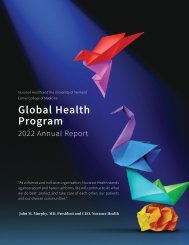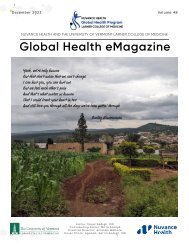eMagazine July 2023
Create successful ePaper yourself
Turn your PDF publications into a flip-book with our unique Google optimized e-Paper software.
OUR PEOPLE,<br />
OUR MISSION<br />
Global Health<br />
<strong>eMagazine</strong><br />
<strong>July</strong> <strong>2023</strong><br />
Highlights<br />
Among the Letters<br />
Reflections<br />
Hispanic and Latinx Voices<br />
Global Local<br />
Art to Remind Us of Who We<br />
Can Be<br />
Our Beautiful Planet<br />
Voices of Ugandan<br />
Students<br />
Nursing Division<br />
Congratulations<br />
Video of the Month<br />
Article of the Month<br />
Calendar<br />
Global Health Family<br />
Photo News<br />
Resources<br />
Previous Issues of<br />
the <strong>eMagazine</strong><br />
Global Local<br />
Health Disparities within our Borders<br />
Section Editor: Ritesh Vidhun<br />
Food Deserts in the United States: Impact<br />
on Healthcare<br />
Written by Ritesh Vidhun<br />
Access to healthy and nutritious food is a fundamental<br />
necessity for good health. However, access to these<br />
products is often challenging for many communities<br />
across the United States. Regions where these foods,<br />
particularly fresh fruits, vegetables, and whole grains,<br />
are limited are referred to as “food deserts.” There are specific metrics to classify<br />
these areas developed by the US Department of Agriculture (USDA) which are<br />
used by other agencies and organizations.1 This month’s piece will explore the<br />
concept of food deserts in the US, utilizing relevant sources, and discuss their<br />
profound impact on healthcare.<br />
Defining Food Deserts:<br />
According to the USDA, a food desert is<br />
typically an urban or rural area lacking<br />
in reliable access to grocery stores or<br />
other outlets offering fresh, healthy, and<br />
affordable food. 1 In these areas, residents<br />
often rely on convenience stores or fastfood<br />
restaurants, leading to a scarcity of<br />
nutritious options. The lack of access is<br />
influenced by factors such as distance<br />
to grocery stores, transportation<br />
limitations, income disparities, and the<br />
absence of quality food suppliers. The<br />
underlying reasons for its existence is rooted in systemic issues of inequity, but<br />
not the focus of this edition.<br />
Extent of the Problem:<br />
Food deserts are pervasive across the United States, affecting both urban and rural<br />
populations. According to a report by the USDA, approximately 19 million people<br />
live in food deserts, with low-income neighborhoods being disproportionately<br />
impacted. 2 The problem is especially prevalent in underserved communities,<br />
where socioeconomic factors intertwine with limited access to exacerbate health<br />
disparities.<br />
20<br />
Global Local continued on next page >>

















